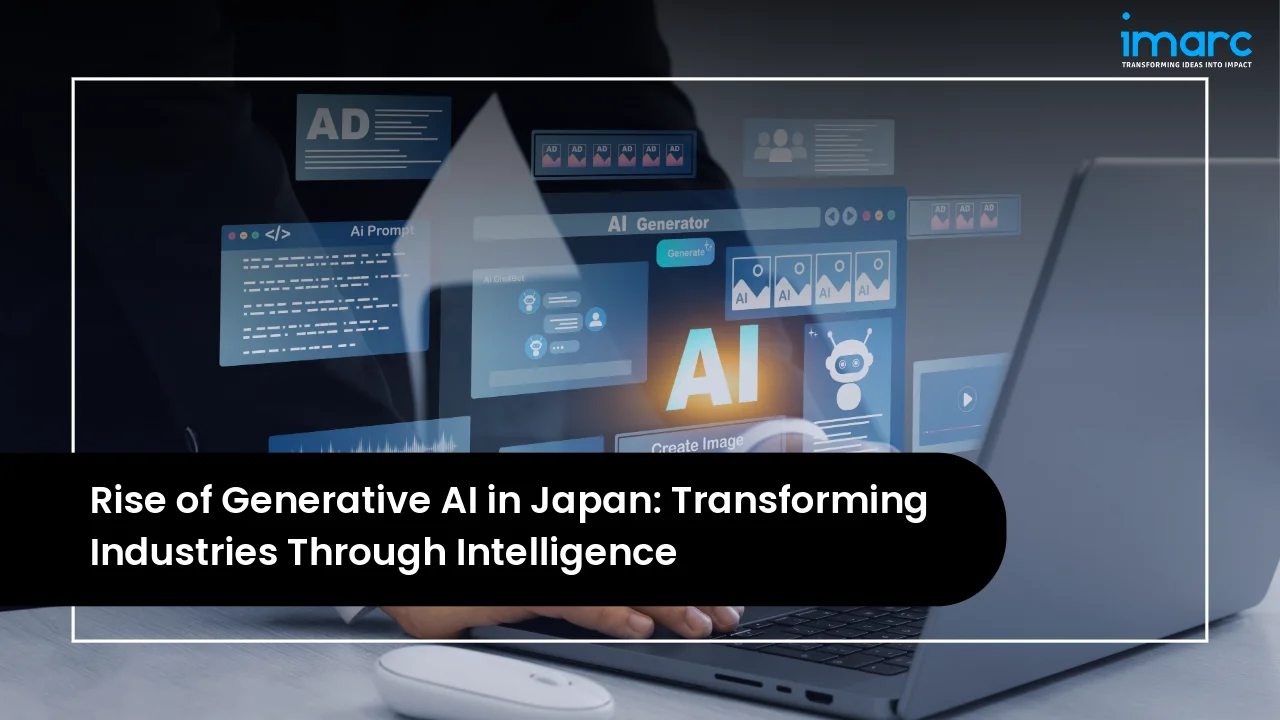Rise of Generative AI in Japan: Transforming Industries Through Intelligence

Generative artificial intelligence (AI) is rapidly becoming one of the most influential technologies of the decade, and its global footprint is continuously expanding. Nations across the world are exploring its transformative potential, with Japan emerging as a unique hub where technological innovation, traditional industries, and forward-looking government policies are converging. The Japan generative AI market is presently playing a critical role in redefining industrial competitiveness, cultural creativity, and healthcare innovation, while also presenting challenges that need careful navigation.

Explore in-depth findings for this market, Request Sample
From Science Fiction to Reality: Generative AI’s Global Momentum
Generative AI is standing at the forefront of digital transformation in Japan. Unlike earlier AI models that were primarily analytical, generative systems are producing text, images, video, and even product designs with remarkable speed and accuracy. Japanese corporations are integrating these technologies into operations, enabling cost savings, accelerated product development, and enhanced customer engagement.
This rise in adoption is not confined to technology companies alone. Retailers are deploying generative AI for personalized shopping experiences, pharmaceutical firms are using it to discover new drug compounds, and entertainment industries are creating AI-driven scripts and visuals. For instance, in 2025, Fujitsu Limited and the Japan Research Institute Limited (JRI) announced the successful conclusion of phase one of a collaborative verification study regarding a system upgrade initiative for Sumitomo Mitsui Banking Corporation (SMBC). The initiative employs generative AI to enhance efficiency in resolving incompatibilities resulting from the upgrade of Red Hat Enterprise Linux (RHEL) version. The verification study, carried out between November 5, 2024, and January 15, attained a 65% decrease in workload as compared to traditional methods. Fujitsu and JRI started working on the incompatibilities found in the verification study on January 16, 2025.
Why Japan is Carving Its Own Path in the Generative AI Era:
Japan’s role in the global generative AI movement is distinct. Unlike some regions where adoption is driven primarily by startups or digital-first enterprises, Japan is integrating generative AI into its long-standing industrial strengths like manufacturing, automotive engineering, and robotics while also leveraging its cultural edge in creative industries, such as gaming, anime, and media.
The Japanese market is benefiting from a combination of strong technological infrastructure, world-class research institutions, and a society accustomed to embracing robotics and automation. Additionally, Japan’s government is actively supporting AI adoption through policy frameworks that emphasize both innovation and ethical responsibility.
Reinventing Industries: Where Generative AI Is Making the Biggest Impact
Japan’s industrial ecosystem is undergoing a profound shift as generative AI begins to shape workflows across multiple domains. Leading corporations and startups alike are adopting generative models to accelerate innovation, reduce operational inefficiencies, and unlock new revenue streams.
The transformation is particularly visible in sectors, such as manufacturing, automotive, healthcare, and creative industries, where Japan holds long-established global leadership. In these areas, generative AI is not simply automating tasks but is also reshaping design, research, and user engagement. For instance, in 2025, Hippocratic AI, a global frontrunner in safety-oriented generative AI agents for healthcare, partnered with EUCALIA Inc., a Tokyo-centered healthcare transformation firm dedicated to enhancing clinical operations and improving care delivery, to introduce the first Japanese-language generative AI healthcare agent for non-diagnostic, patient-oriented clinical tasks. This signifies Hippocratic AI's launch in the Japanese market, furthering its worldwide goal to provide abundant healthcare via technology.
Engineering Future: Generative AI in Manufacturing and Automotive
Manufacturing is one of Japan’s economic pillars, and the integration of generative AI is redefining its value chain. Advanced models are continuously being deployed to design lighter, more efficient components, simulate production processes, and predict maintenance requirements for machinery. This is enabling companies to reduce downtime and optimize resource utilization.
In the automotive sector, which remains a global symbol of Japanese innovation, generative AI is reshaping how cars are being designed, tested, and marketed. From creating aerodynamic prototypes to generating personalized driving experiences, automakers are relying on generative systems to accelerate research and development (R&D). Additionally, AI-driven predictive modelling is being used to advance autonomous driving technologies, a field where Japanese firms are intensifying their investments. In 2024, Toyota Motor Corporation declared its initiatives to build a network of generative AI agents designed to archive and disseminate internal knowledge aimed at accelerating the development of new vehicle models, despite a mass exodus of engineers retiring.
Healing Smarter: How Generative AI Is Transforming Healthcare
Healthcare and life sciences in Japan are also experiencing a significant shift through generative AI applications. Research institutions and pharmaceutical companies are using generative models to simulate protein structures, design new drug compounds, and predict patient-specific treatment outcomes. These innovations are not only reducing the time and cost of drug discovery but are also improving precision in medical interventions.
Hospitals and clinics are adopting generative AI for administrative functions, such as automating patient documentation, generating medical summaries, and personalizing patient engagement. In a society with a rapidly aging population, these solutions are helping alleviate pressure on healthcare systems and professionals.
Moreover, Japanese researchers are exploring the ethical dimensions of AI in medicine, ensuring that generative models align with patient safety, transparency, and data security standards. This balance of innovation and responsibility is positioning Japan as a trusted leader in AI-driven healthcare. In 2025, Avalue Technology Inc., a worldwide frontrunner in industrial computing solutions, will take part in the International Modern Hospital Show 2025 in Tokyo, Japan (Booth 162), where it will display an extensive array of intelligent healthcare solutions for patient wards, diagnostics, nurse stations, and surgical rooms. Focusing on the theme “AI Medical Applications and Smart Ward Integration,” Avalue showcases its creativity and capabilities in transforming digital healthcare.
Creativity Reimagined: Generative AI in Japan’s Media and Entertainment
Japan’s creative industries are world-renowned, from anime and video games to literature and advertising. Generative AI is now entering this space as a creative partner, enabling content creators to accelerate idea generation, automate production tasks, and explore entirely new storytelling formats.
Game developers are using AI to design immersive virtual worlds, while media companies are producing AI-generated advertising content tailored to diverse audiences. In the anime sector, generative AI is assisting with character design, scene creation, and voice synthesis, helping studios meet global demand while reducing production bottlenecks. Japanese game developer Colopl, which includes former Shin Megami Tensei and Persona artist Kazuma Kaneko, has recently disclosed that nearly 80% of its employees utilize generative AI in their tasks. According to Otaku Soken, this information came to light through an internal survey released by the company. Colopl is recognized for games such as Shironeko Project (White Cat Project), Isekai ∞ Isekai, and Tsukuyomi: The Divine Hunter.
The fusion of Japan’s cultural creativity with generative technologies is reinforcing its position as a global content powerhouse. The market is thus extending beyond traditional industries, influencing how global audiences consume entertainment.
Innovation on Rise: Startups and Tech Giants Driving Growth
Japan’s startup ecosystem is emerging as a vital driver of generative AI innovation. A growing number of AI-focused startups are offering solutions for everything from automated business intelligence to creative content generation. These startups are increasingly collaborating with universities and research institutes, accelerating the commercialization of AI breakthroughs.
At the same time, established technology giants are making major investments in generative AI research and applications. Collaborative ventures between these companies and startups are helping scale AI adoption across industries. This ecosystem of collaboration is ensuring that the Japan generative AI industry is not only competitive domestically but also influential on a global scale.
Policy in Action: Government Support for Generative AI Growth
Government initiatives are playing a central role in shaping Japan’s AI journey. Policies are being designed to encourage innovation while maintaining strong ethical and regulatory oversight. The Japanese government is actively investing in AI research, supporting public-private partnerships, and promoting AI adoption in sectors such as healthcare, education, and public services.
A notable aspect of Japan’s policy approach is its focus on balancing technological advancement with social responsibility. Regulations around data privacy, algorithmic transparency, and workforce transformation are being integrated into AI governance frameworks. This balanced approach is helping build public trust and encouraging industries to adopt AI technologies more confidently. For example, in 2025, the Act to Promote Research and Development and the Use of AI-Related Technologies got approved by the House of Councilors on 28 May after being passed in the House of Representatives in April. The legislation explicitly expresses the legislature's desire for AI to prosper in the nation, declaring outright that "technologies related to AI are essential for the advancement of Japan's economy and society." It describes its structure as "basic" and depends on business collaboration and existing regulations to govern the technology instead of creating a new framework.
Facing Roadblocks: Ethical, Regulatory, and Adoption Challenges
Despite rapid progress, the adoption of generative AI in Japan is not without challenges. Concerns around data privacy, intellectual property rights, and algorithmic bias are being raised, requiring careful regulatory oversight. The integration of AI into industries also demands workforce upskilling, as employees need training to work effectively alongside AI-driven systems.
There are also cultural challenges, as businesses and consumers are evaluating the ethical implications of AI-generated content, particularly in creative and academic contexts. Ensuring that generative AI complements rather than replaces human creativity and decision-making remains a critical priority.
These challenges are not deterring progress but are shaping a more measured and thoughtful adoption curve for the market.
Looking Ahead: Japan’s Role in the Global Generative AI Revolution
As generative AI continues to evolve, Japan is positioning itself as a key contributor to the global AI frontier. By integrating generative technologies into its industrial strengths, fostering collaboration between startups and tech giants, and supporting innovation through policy, Japan is demonstrating a model that blends technological ambition with cultural and ethical awareness.
The future of the market is likely to involve deeper integration into everyday life, from personalized healthcare and smart manufacturing to AI-assisted creativity and autonomous systems. Japan’s ability to balance innovation with responsibility will define its global influence, making it a pivotal player in shaping how generative AI transforms societies worldwide.
Leading Innovation: IMARC Group's Contribution to the Japan Generative AI Market
IMARC Group is providing decisive insights into the growing market, helping decision-makers across technology, manufacturing, healthcare, and creative industries to navigate a changing digital world. Our services are facilitating informed decision-making on adoption, investment, and policy alignment through:
- Market Intelligence and Insights: Exhaustive analysis of Japan's generative AI ecosystem, adoption trends, sector-specific uses, and integration issues. Insights include opportunities in manufacturing, automotive, healthcare, media, and more.
- Strategic Forecasting: Future-looking assessments of market growth patterns, investment channels, and industry demand. Projections evaluate how generative AI will influence efficiency, innovation, and competitiveness in Japan's tech-driven economy.
- Competitive Benchmarking: Ongoing tracking of local and international players that are influencing the Japan Generative AI Market, such as start-ups, technology leaders, and cross-industry partnerships. Evaluations emphasize innovation pipelines, partnership strategies, and market positioning.
- Policy and Regulatory Analysis: Analysis of AI-related policies in Japan, ethical guidelines, and data protection laws. Recommendations emphasize adherence to national strategy, government programs, and changing regulatory environments.
- Tailored Consulting Solutions: Bespoke strategies created to facilitate AI integration, workforce reform, and innovation acceleration. Solutions are coordinating industry players with Japan's capabilities in manufacturing, healthcare, and creative industries while guaranteeing responsible and ethical implementation.
Our Clients
Contact Us
Have a question or need assistance?
Please complete the form with your inquiry or reach out to us at
Phone Number
+91-120-433-0800+1-201-971-6302
+44-753-714-6104
.webp)










